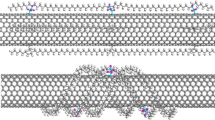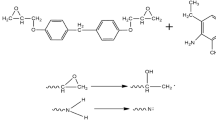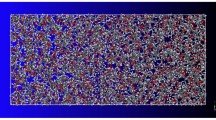Abstract
The mechanical performance of carbon nanotube (CNT) reinforced polymer composites is primarily controlled by the dispersive capacity and interfacial shear strength of CNTs in polymer matrices. CNT functionalizations will improve dispersion and strengthen interfacial bonding of CNTs in matrices. To understand the effects of different functionalization schemes on the interfacial strength of CNT-polymer composites, pullout of the covalent, noncovalent, and mixed functionalized single-walled carbon nanotube (SWCNT) from polyethylene (PE) matrix was simulated by using molecular dynamics, respectively. The results show that the SWCNT-PE interfacial shear strength is significantly improved by SWCNT functionalizations, particularly by mixed functionalization.
Similar content being viewed by others
References
Calvert, P., Nanotube composites: a recipe for strength. Nature, 1999, 399: 210–211.
Gojny, F.H., Nastalczyk, J., Roslamiec, Z. and Schulte, K., Surface modified multi-walled carbon nanotubes in CNT/epoxy-composites. Chemical Physics Letters, 2003, 370: 820–824.
Zhu, J., Kim, J.D., Peng, H.Q., Margrave, J.L., Khabashesku, V.N. and Barrera, E.V., Improving the dispersion and integration of single-walled carbon nanotubes in epoxy composites through functionalization. Nano Letters, 2003, 3: 1107–1113.
Jin, L., Bower, B. and Zhou, O., Alignment of carbon nanotubes in a polymer matrix by mechanical stretching. Applied Physics Letters, 1998, 73: 1197–1199.
Schadler, L.S., Giannaris, S.C. and Ajayan, P.M., Load transfer in carbon nanotube epoxy composites. Applied Physics Letters, 1998, 73: 3842–3844.
Sinnott, S.B., Chemical functionalization of carbon nanotubes. Journal of Nanoscience and Nanotechnology, 2002, 2: 113–123.
Li, X.D., Gao, H.S., Scrivens, W.A., Fei, D.L., Xu, X.Y., Sutton, M.A., Reynolds, A.P. and Myrich, M.L., Nanomechanical characterization of single-walled carbon nanotube reinforced epoxy composites. Nanotechnology, 2004, 15: 1416–1423.
Ajayan, P.M., Schadler, L.S., Giannaris, C. and Rubio, A., Single-walled carbon nanotube polymer composites: strength and weakness. Advanced Materials, 2000, 12: 750–753.
Eitan, A., Jiang, K.Y., Dukes, D., Andrews, R. and Schadler, L.S., Surface modification of multiwalled carbon nanotubes: toward the tailoring of the interface in polymer composites. Chemistry of Materials, 2003, 15: 3198–3201.
Steuerman, D.W., Star, A., Narizzano, R., Choi, H., Ries, R.S., Nicolini, C., Stoddart, J.F. and Heath, J.R., Interactions between conjugated polymers and single-walled carbon nanotubes. The Journal of Physical Chemistry B, 2002, 106: 3124–3130.
Hamon, M.A., Hu, H., Bhowmik, P., Itkis, H.M.E. and Haddon, R.C., Ester-functionalized soluble single-walled carbon nanotubes. Applied Physics A, 2002, 74: 333–338.
Chen, J., Hamon, M.A., Hu, H., Chen, Y.S., Rao, A.M., Eklund, P.C. and Haddon, R.C., Solution properties of single-walled carbon nanotubes. Science, 1998, 282: 95–98.
Frankland, S.J.V., Caglar, A., Brenner, D.W. and Griebel, M., Molecular simulation of the influence of chemical cross-links on the shear strength of carbon nanotube-polymer interfaces. The Journal of Physical Chemistry B, 2002, 106: 3046–3048.
Namilae, S. and Chandra, N., Multiscale model to study the effect of interfaces in carbon nanotube-based composites. Journal of Engineering Materials and Technology, 2005, 127: 222–232.
Lordi, V. and Yao, N., Molecular mechanics of binding in carbon-nanotube-polymer composites. Journal of Materials Research, 2000, 15: 2770–2779.
Chen, R.J., Zhang, Y.G., Wang, D.W. and Dai, H.J., Noncovalent sidewall functionalization of single-walled carbon nanotubes for protein immobilization. Journal of the American Chemical Society, 2001, 123: 3838–3839.
O’Connell, M.J., Boul, P., Ericson, L.M., Huffman, C., Wang, Y.H., Haroz, E., Kuper, C., Tour, J., Ausman, K.D. and Smalley, R.E., Reversible water-solubilization of single-walled carbon nanotubes by polymer wrapping. Chemical Physics Letters, 2001, 342: 265–271.
Liu, J.Q., Xiao, T., Liao, K. and Wu, P., Interfacial design of carbon nanotube polymer composites: hybrid system of noncovalent and covalent functionalization. Nanotechnology, 2007, 18: 165701.
Wei, C.Y., Adhesion and reinforcement in carbon nanotube polymer composite. Applied Physics Letters, 2006, 88: 093108.
Zhang, Q., Qi, Y., Hector, L.G., Cagin, T. and Goddard, W.A., Origin of static friction and its relationship to adhesion at the atomic scale. Physical Review B, 2007, 75: 144114.
Huq, A.M.A., Goh, K.L., Zhou, Z.R. and Liao, K., On defect interactions in axially loaded single-walled carbon nanotubes. Journal of Applied Physics, 2008, 103: 054306.
Pitkethly, M.J. and Doble, J.B., Characterizing the fiber/matrix interface of carbon fiber-reinforced composites using a single fiber pull-out test. Composites, 1990, 21: 389–395.
Cooper, C.A., Cohen, S.R., Barber, A.H. and Wagner, H.D., Detachment of nanotubes from a polymer matrix. Applied Physics Letters, 2002, 81: 3873–3875.
Barber, A.H., Cohen, S.R. and Wagner, H.D., Measurement of carbon nanotube-polymer interfacial strength. Applied Physics Letters, 2003, 82: 4140–4142.
Liao, K. and Li, S., Interfacial characteristics of a carbon nanotube-polystyrene composite system. Applied Physics Letters, 2001, 79: 4225–4227.
Wei, C.Y., Structural phase transition of alkane molecules in nanotube composites. Physical Review B, 2007, 76: 134104.
Chen, S.M., Shen, W.M., Wu, G.Z., Chen, D.Y. and Jiang, M., A new approach to the functionalization of single-walled carbon nanotubes with alkyl and carboxyl groups. Chemical Physics Letters, 2005, 402: 312–317.
Liu, L.Q. and Wagner, H.D., A comparison of the mechanical strength and stiffness of MWNT-PMMA and MWNT-epoxy nanocomposites. Composite Interfaces, 2007, 14: 285–297.
in het Panhuis, M., Maiti, A., Dalton, A.B., van den Noort, A., Coleman, J.N., McCarthy, B. and Blau, W.J., Selective interaction in a polymer-single-wall carbon nanotube composite. The Journal of Physical Chemistry B, 2003, 107: 478–482.
Amorphous Cell and Discover are modules in Materials Studio, a software package for materials simulation and modeling, developed by Accelrys®Software Incorporation, USA.
Brandrup, J., Immergut, E.H., Grulke, E.A., Abe, A. and Bloch, D.R., Polymer Handbook. New York: Wiley, 1999.
Sun, H., COMPASS: an ab initio force-field optimized for condensed-phase applications- overview with details on alkane and benzene compounds. The Journal of Physical Chemistry B, 1998, 102: 7338–7364.
Wong, M., Paramsothy, M., Xu, X.J., Ren, Y., Li, S. and Liao, K., Physical interactions at carbon nanotube polymer interface. Polymer, 2003, 44: 7757–7764.
Yang, M., Koutsos, V. and Zaiser, M., Interaction between polymers and carbon nanotubes: a molecular dynamics study. The Journal of Physical Chemistry B, 2005, 109: 10009–10014.
Xia, Z. and Curtin, W.A., Pullout forces and friction in multiwall carbon nanotubes. Physical Review B, 2004, 69: 233408.
Author information
Authors and Affiliations
Corresponding author
Additional information
Project supported by the National Natural Science Foundation of China (No. 11272360), the Natural Science Foundation of Guangdong Province (No. 2014A030313793), and the Research Fund for the Doctoral Program of Higher Education of China (No. 20120171110035).
Rights and permissions
About this article
Cite this article
Xiao, T., Liu, J. & Xiong, H. Effects of Different Functionalization Schemes on the Interfacial Strength of Carbon Nanotube Polyethylene Composite. Acta Mech. Solida Sin. 28, 277–284 (2015). https://doi.org/10.1016/S0894-9166(15)30014-8
Received:
Revised:
Published:
Issue Date:
DOI: https://doi.org/10.1016/S0894-9166(15)30014-8




